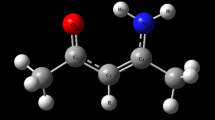Abstract
Glutathione tripeptide (γ-glutamyl-cysteinyl-glycine) is a flexible molecule and its conformational energy landscape is strongly influenced by forming intramolecular hydrogen bond, its charge and the environment. This study employs DFT-B3LYP method with the 6-31+G (d,p) basis set to carry out conformational analysis of neutral, zwitterionic, cationic, and anionic forms of glutathione. In analyzing the structural characteristics of these structures, intramolecular hydrogen bonds were identified and characterized in details by topological parameters such as electron density ρ(r) and Laplacian of electron density \( \nabla^{2} \)ρ(r) from Bader’s atom in molecules theory. Charge transfer energies based on natural bond orbital analysis are also considered to interpret these intramolecular hydrogen bonds. Our results show that these hydrogen bonds are partially electrostatic and partially covalent in nature, in which the covalent contribution increases as the stabilization energy of hydrogen bond increases. Furthermore, the back bone and side chain (Ramachandran map) orientations of various ionic forms of glutathione have been studied and conformation of each constitution of glutathione tripeptide (i.e., Glu, Cys, and Gly moieties) was determined. In most species side chain conformation were found to be hindered gauche–gauche orientation by intramolecular hydrogen bonds.






Similar content being viewed by others
References
Dickinson DA, Forman HJ (2002) Biochem Pharmacol 64:1019
Meister A, Anderson ME (1983) Annu Rev Biochem 52:711
Rabenstein DL, Guevremont R, Evans CA (1997) Metal ions in biological systems, vol 9. Dekker, New York, pp 103–141
Tomaszewska B (2002) In: Prasad MNV, Strzalka K (eds) Physiology and biochemistry of metal toxicity and tolerance in plants. Kluwer, Dordrecht, pp 37–58
Krezel A, Szczepanik W, Sokolowska M, Jewska-Bojczuk M, Bal W (2003) Chem Res Toxicol 16:855
Sies H (1999) Free Rad Biol Med 27:916
Jacob C, Maret W, Vallee BL (1998) Proc Natl Acad Sci USA 95:3489
Reedijk J (1999) Chem Rev 99:2499
Teuben JM, Reedijk J (2000) J Biol Inorg Chem 5:463
Wright WB (1958) Acta Crystallogr 11:632
Gorbitz CH (1987) Acta Crystallogr 41:362
Oakley AJ, Lo Bello M, Battistoni A, Ricci G, Rossjohn J, Villar HO, Parker MW (1997) J Mol Biol 274:84
Raghunathan S, Chandross J, Kretsinger RH, Alliston TJ, Penington CJ, Rule GS (1994) J Mol Biol 238:815
Rabenstein DL (1973) J Am Chem Soc 95:2797
York MJ, Beilharz GR, Kuchel PW (1987) Int J Peptide Protein Res 29:638
Nicotra M, Paci M, Sette M, Oakley AJ, Parker MW, Lo Bello M, Caccuri AM, Federici G, Ricci G (1998) Biochemistry 37:3020
McCallum SA, Hitchens TK, Torborg C, Rule GS (2000) Biochemistry 39:7343
Laurence PR, Thomson C (1980) Theor Chim Acta 57:2541
Rauk A, Armstrong DA, Berges J (2001) Can J Chem 79:405
De Blumenfeld MP, Hikichi N, Hansz M, Ventura ON (1990) J Mol Struct (Theochem) 210:467
Cubas ML, Ventura ON (1991) J Braz Chem Soc 2:111
Wolfe S, Weaver DF, Yang K (1988) Can J Chem 66:2687
Singh BK, Mishra PC, Garg BS (2007) Spectrochim Acta A 67:719
Klipfel MW, Zamora MA, Rodriguez AM, Fidanza NG, Enriz RD, Csizmadia IG (2003) J Phys Chem A 107:5079
Zamora MA, Baldoni HA, Rodriguez AM, Enriz RD, Sosa CP, Perczel A, Kucsman A, Farkas O, Deretey E, Vank JC, Csizmadia IG (2002) Can J Chem 80:832
Spartan ‘06V102’ (2006) Wavefunction, Inc., Irvine
Becke AD (1993) J Chem Phys 98:5648
Lee C, Yang W, Parr RG (1988) Phys Rev B 37:785
Reed AE, Weinhold F (1985) J Chem Phys 83:1736
Reed AE, Weinstock RB, Weinhold F (1985) J Chem Phys 83:735–746
Reed AE, Weinhold F (1983) J Chem Phys 78:4066
Foster JP, Weinhold F (1980) J Am Chem Soc 102:7211
Chocholousova J, Vladimir Spirko V, Hobza P (2004) Phys Chem Chem Phys 6:37–41
Bader RFW (1990) Atoms in molecules: a quantum theory. Clarendon Press, Oxford
Arnold WD, Oldfield E (2000) J Am Chem Soc 122:12835
Pacios LF (2004) J Phys Chem A 108:1177
Espinosa E, Molins E, Lecomte C (1998) Chem Phys Lett 285:170
Yurenko YP, Zhurakivsky RO, Samijlenko SP, Ghomi M, Hovorun DM (2007) Chem Phys Lett 447:140
Yurenko YP, Zhurakivsky RO, Samijlenko SP, Hovorun DM (2011) Biomol Struct Dyn 1:51
Bader RFW (2002) AIM2000 program package, Ver. 2.0. McMaster University, Hamilton
IUPAC-IUB Commission on Biochemical Nomenclature (1970) Biochemistry 9:3471
Jelsch C, Didierjean C (1999) Acta Crystallogr C 55:1538
Alkorta I, Rozas I, Elguero J (1998) Chem Soc Rev 27:163
Huang Zh, Yu W, Lin Z (2006) J Mol Struct (Theochem) 801:7
Koch U, Popelier PLA (1995) J Phys Chem 99:9747
Popelier PLA (1998) J Phys Chem A 102:1873
Popelier PLA (2000) Atoms in molecules. An introduction. Prentice Hall, Harlow
Wiberg KB, Bader RFW, Lau CDH (1987) J Am Chem Soc 109:1001
Bianchi R, Gervasio G, Marabello D (2000) Inorg Chem 39:2360
Reed AE, Curtiss LA, Weinhold F (1988) Chem Rev 88:899
Acknowledgments
Support from Sharif University of Technology is gratefully acknowledged.
Author information
Authors and Affiliations
Corresponding author
Rights and permissions
About this article
Cite this article
Aliakbar Tehrani, Z., Fattahi, A. Conformational aspects of glutathione tripeptide: electron density topological & natural bond orbital analyses. Struct Chem 24, 147–158 (2013). https://doi.org/10.1007/s11224-012-0023-1
Received:
Accepted:
Published:
Issue Date:
DOI: https://doi.org/10.1007/s11224-012-0023-1




